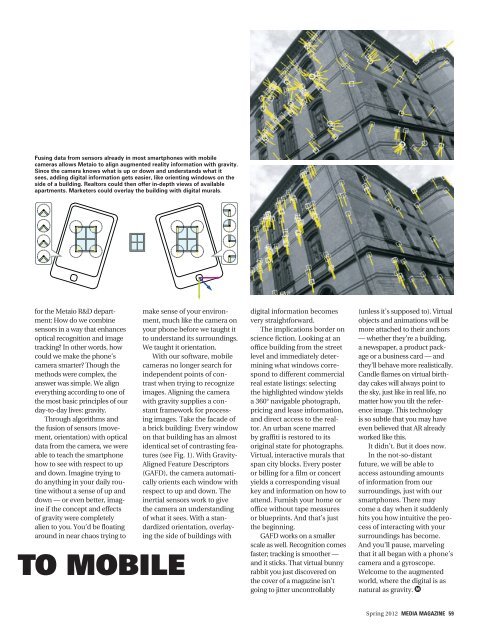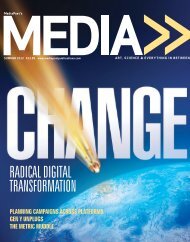THIRD ANNUAL SCREENS ISSUE - MediaPost
THIRD ANNUAL SCREENS ISSUE - MediaPost
THIRD ANNUAL SCREENS ISSUE - MediaPost
Create successful ePaper yourself
Turn your PDF publications into a flip-book with our unique Google optimized e-Paper software.
Fusing data from sensors already in most smartphones with mobile<br />
cameras allows Metaio to align augmented reality information with gravity.<br />
Since the camera knows what is up or down and understands what it<br />
sees, adding digital information gets easier, like orienting windows on the<br />
side of a building. Realtors could then offer in-depth views of available<br />
apartments. Marketers could overlay the building with digital murals.<br />
for the Metaio R&D department:<br />
How do we combine<br />
sensors in a way that enhances<br />
optical recognition and image<br />
tracking? In other words, how<br />
could we make the phone’s<br />
camera smarter? Though the<br />
methods were complex, the<br />
answer was simple. We align<br />
everything according to one of<br />
the most basic principles of our<br />
day-to-day lives: gravity.<br />
Through algorithms and<br />
the fusion of sensors (movement,<br />
orientation) with optical<br />
data from the camera, we were<br />
able to teach the smartphone<br />
how to see with respect to up<br />
and down. Imagine trying to<br />
do anything in your daily routine<br />
without a sense of up and<br />
down — or even better, imagine<br />
if the concept and effects<br />
of gravity were completely<br />
alien to you. You’d be floating<br />
around in near chaos trying to<br />
TO MOBILE<br />
make sense of your environment,<br />
much like the camera on<br />
your phone before we taught it<br />
to understand its surroundings.<br />
We taught it orientation.<br />
With our software, mobile<br />
cameras no longer search for<br />
independent points of contrast<br />
when trying to recognize<br />
images. Aligning the camera<br />
with gravity supplies a constant<br />
framework for processing<br />
images. Take the facade of<br />
a brick building: Every window<br />
on that building has an almost<br />
identical set of contrasting features<br />
(see Fig. 1). With Gravity-<br />
Aligned Feature Descriptors<br />
(GAFD), the camera automatically<br />
orients each window with<br />
respect to up and down. The<br />
inertial sensors work to give<br />
the camera an understanding<br />
of what it sees. With a standardized<br />
orientation, overlaying<br />
the side of buildings with<br />
digital information becomes<br />
very straightforward.<br />
The implications border on<br />
science fiction. Looking at an<br />
office building from the street<br />
level and immediately determining<br />
what windows correspond<br />
to different commercial<br />
real estate listings: selecting<br />
the highlighted window yields<br />
a 360° navigable photograph,<br />
pricing and lease information,<br />
and direct access to the realtor.<br />
An urban scene marred<br />
by graffiti is restored to its<br />
original state for photographs.<br />
Virtual, interactive murals that<br />
span city blocks. Every poster<br />
or billing for a film or concert<br />
yields a corresponding visual<br />
key and information on how to<br />
attend. Furnish your home or<br />
office without tape measures<br />
or blueprints. And that’s just<br />
the beginning.<br />
GAFD works on a smaller<br />
scale as well. Recognition comes<br />
faster; tracking is smoother —<br />
and it sticks. That virtual bunny<br />
rabbit you just discovered on<br />
the cover of a magazine isn’t<br />
going to jitter uncontrollably<br />
(unless it’s supposed to). Virtual<br />
objects and animations will be<br />
more attached to their anchors<br />
— whether they’re a building,<br />
a newspaper, a product package<br />
or a business card — and<br />
they’ll behave more realistically.<br />
Candle flames on virtual birthday<br />
cakes will always point to<br />
the sky, just like in real life, no<br />
matter how you tilt the reference<br />
image. This technology<br />
is so subtle that you may have<br />
even believed that AR already<br />
worked like this.<br />
It didn’t. But it does now.<br />
In the not-so-distant<br />
future, we will be able to<br />
access astounding amounts<br />
of information from our<br />
surroundings, just with our<br />
smartphones. There may<br />
come a day when it suddenly<br />
hits you how intuitive the process<br />
of interacting with your<br />
surroundings has become.<br />
And you’ll pause, marveling<br />
that it all began with a phone’s<br />
camera and a gyroscope.<br />
Welcome to the augmented<br />
world, where the digital is as<br />
natural as gravity.<br />
Spring 2012 MEDIA MAGAZINE 59








